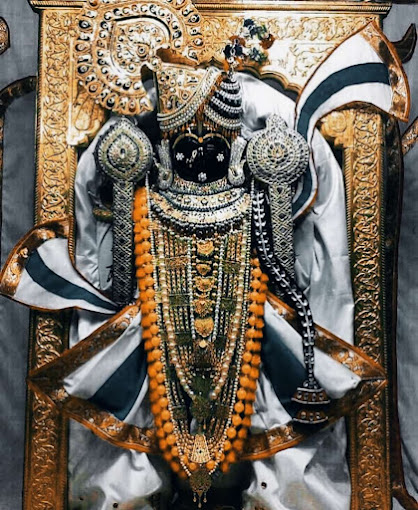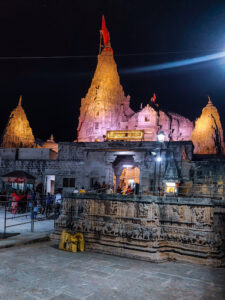About Dwarkadhish Temple:
The Dwarkadhish temple, also known as the Jagat Mandir and often spelt Dwarakadheesh, is a Hindu temple devoted to Krishna, who is known as Dwarkadhish, or ‘King of Dwarka’ here. The temple is located in Dwarka, Gujarat, India, and is one of the stops on the Char Dham pilgrimage circuit. Shree Dwarkadhish Temple is one of the famous temples in gujarat.
Dwarkadhish Temple History:
Dwarka, a town in Gujarat, has a long history and is mentioned in the Mahabharata epic as the Dwaraka Kingdom. The town, located on the banks of the Gomti River, is depicted in legend as Krishna’s capital. Evidence such as a stone block with script, the way the stones were dressed indicating the use of dowels, and an investigation of anchors found on the site suggest that the harbour site is only historical, with some of the underwater structure dating from the late Middle Ages. The destruction of what was once a historic harbour was most likely caused by coastal erosion.
Hindus say that the initial temple was built above Krishna’s residence palace by Vajranabh, Krishna’s great grandson. Sultan Mahmud Begada destroyed it in 1472.
The contemporary Chalukya-style temple was built in the 15-16th century. The temple has a 27-metre by 21-metre footprint, a 29-metre east-west length, and a 23-metre north-south width. The temple’s highest point is 51.8 metres high.
Architecture of Dwarkadhish Temple Gujarat:
It is a five-story structure supported by 72 pillars.The Dwarkadhish Temple has two prominent entrances: the main entry door, known as the Moksha Dwar, and the exit door, known as the Swarga Dwar.
The principal god deified in the sanctum is Dwarkadeesh, also known as Vishnu’s Trivikrama form, and is represented with four arms.The deity of Balarama, Krishna’s elder brother, can be seen in the chamber to the left of the main altar. The images of Krishna’s son and grandson, Pradyumna and Aniruddha, are housed in the chamber to the right. There are idols of Radha, Jambavati, Satyabhama, and Lakshmi in various shrines surrounding the centre shrine. The temple also contains shrines to Madhav Raoji (another name for Krishna), Balrama, and the guru Durvasa.Just in front of the major shrine of Dwarkadhish, there are two other shrines devoted to Radha Krishna and Devaki.
The mandir dwarkadhish spire rises to 78 metres in height, and a big flag with Sun and Moon motifs is flown above it.The triangular flag measures 50 feet in length. This flag is replaced four times every day, and Hindus spend a large quantity of money to hoist it by purchasing a new flag. The money received on this account is credited to the temple’s trust fund, which is used to cover the temple’s operating and maintenance costs.
Legend of the Temple:
According to Hindu belief, Krishna reclaimed a strip of land from the sea to build Dwarka. Krishna and his wife Rukmini were once visited by Sage Durvasa. The sage wished the couple would take him to their palace. The two happily consented and began strolling to their palace with the sage. Rukmini became exhausted after a short journey and asked Krishna for some water. Krishna excavated a mythological hole that transported the Ganga to the location. Sage Durvasa was enraged and cursed Rukmini to stay at the location. The temple where Rukmini’s shrine is located is thought to be the location where she stood.
Importance of Dwarkadhish Mandir:
This dwarkadhish mandir is significant for Hindu pilgrims because it is associated with the ancient city of Dvrak and the Vedic era Krishna of the Mahabharata. It is one of three major pilgrimage sites associated with the “Krishna” circuit, the others being the 48 kos parikrama of Kurukshetra in Haryana, Braj Parikrama in Mathura in Uttar Pradesh, and Dwarka Parikrama (Dwarkadish Yatra) in Dwarkadhish Temple in Gujarat.
The sun and moon are shown on the temple’s flag, which is thought to imply that Krishna will be present as long as the sun and moon exist on Earth. The flag is changed up to five times per day, however the emblem does not change. The temple is a five-story edifice supported by 72 pillars. The temple spire stands 78.3 metres tall.The temple is made of limestone and is in excellent shape. Intricate sculptural work can be found throughout the temple.
There are two ways to enter the temple. “Moksha Dwara” (Door to Salvation) is the name of the main entryway (north entrance). This door leads to the main market. The south entrance is known as “Swarga Dwara” (Heaven’s Gate). There are 56 steps outside this doorway that lead to the Gomati River.Though the origins are unknown, the Advaita school of Hinduism founded by Sankaracharya, who established Hindu monastic institutions across India, attributes Char Dham to the seer. The four monasteries are spread across India, with attendant temples at Badrinath in the north, Jagannath Temple in Puri in the east, Dwarakadheesh Temple in Dwarka in the west, and Ramanathaswamy Temple in Rameswaram in the south.
Click here to know about Somnath Temple in Gujarat
Dwarkadhish Temple Timings:
The timings of dwarkadhish temple are Morning 6.30 am to Afternoon 01.00 pm
and Evening 5.00 pm to 9.30 pm
On special days/festivals, timings may vary
Dwarkadhish Temple Darshan Timings:
Morning 6.30 am – Mangla Arti
7.00 am to 8.00 am – Mangla Darshan
8.00 am to 9.00 am – Abhishek Pooja [Snan Vidhi]: Darshan Closed
9.00 am to 9.30 am – Shringar Darshan
9.30 am to 9.45 am – Snanbhog : Darshan Closed
9.45 am to 10.15 am – Shringar Darshan
10.15 am to 10.30 am – Shringarbhog: Darshan Closed
10.30 am – to 10.45 am – Shringar Arti
11.05 am to 11.20 am – Gwal Bhog: Darshan Closed
11.20 am to 12.00 pm – Darshan
12.00 pm to 12.20 pm – Rajbhog: Darshan Closed
12.20 pm to 12.30 pm – Darshan
13.00 pm – Anosar, Darshan Closed
5.00 pm – Uthappan First Darshan
5.30 pm to 5.45 pm – Uthappan Bhog: Darshan Closed
5.45 pm to 7.15 pm – Darshan
7.15 pm to 7.30 pm – Sandhya Bhog: Darshan Closed
7.30 pm to 7.45pm – Sandhya Arti
8.00 pm to 8.10pm – Shayanbhog: Darshan Closed
8.10 pm to 8.30 pm – Darshan
8.30pm to 8.35 pm – Shayan Arti
8.35 pm to 9.00 pm – Darshan
9.00 pm to 9.20 pm – Bantabhog and Shayan : Darshan Closed
9.20 pm to 9.30 pm – Darshan
9.30 pm – Darshan Mandir Closed
Dwarkadhish Temple Online booking:
There is no online booking available at Dwarkadhish Mandir. You must purchase your darshan tickets at the temple booth upon arrival.
Festivals Celebrated at Dwarkadhish Temple:
Janmashtami
Annakut Utsav
Tulsi Vivah
Holi
Akshaya Tritiya
Rath Yatra
How to reach the Shree Dwarkadhish Temple?
By Train: Dwarka railway station is the nearest railway station to the temple, which is connected to major cities in Gujarat and other states. Some of the popular trains are Saurashtra Express, Dwarka Express, and Okha Express.
By Bus: Dwarka is well connected by road with major cities in Gujarat. State transport buses, as well as private buses, are available from Ahmedabad, Rajkot, Vadodara, and other major cities in Gujarat. You can also take a bus from Mumbai or Pune to reach Dwarka.
By Road: You can also drive to Dwarka from nearby cities like Ahmedabad, Rajkot, and Jamnagar. The distance between Ahmedabad and Dwarka is around 440 km, and it takes approximately 8 hours to reach by road.
Once you reach Dwarka, you can take a taxi, auto-rickshaw, or local bus to reach the Dwarkadhish Temple. It is located in the heart of the city and is easily accessible.
Temples near to Dwarkadhish Temple Gujarat:
Gita Mandir
Bhadkeshwar Mahadev Mandir
ISKCON Dwarka
Gayatri Shaktipeeth
Samudra Narayan temple
Dwarkadhish Temple Address:
Shree Dwarkadhish Temple Dwarka: 361 335, Dist: Jamnagar, Gujarat- India.
Dwarkadhish Temple Distance:
dwarkadhish temple to somnath temple distance: 3 hr 46 min (236.3 km) via NH51
Mathura to dwarkadhish temple distance: 17 min (3.6 km) via Bhuteshwar Rd
Ahmedabad to Dwarkadhish Temple distance: 9 min (2.6 km) via Ganesh Vasudev Mavalankar Rd and Mirzapur Rd
FAQs about Shree Dwarkadhish Temple
What is the significance of Dwarkadhish Temple?
Dwarkadhish Temple is one of the four major Hindu pilgrimage sites, and it is dedicated to Lord Krishna. It is believed that Lord Krishna resided in Dwarka during his lifetime, and the temple was built to commemorate his presence.
What is the best time to visit Dwarkadhish Temple?
The best time to visit Dwarkadhish Temple is from October to March when the weather is pleasant and the temperature is moderate. However, the temple is open throughout the year, and you can visit it any time of the year.
Is there any dress code for visiting Dwarkadhish Temple?
Yes, there is a dress code for visiting the temple. Men are required to wear dhoti or pajamas with a kurta, and women are required to wear saree, salwar kameez, or a dress that covers their legs and arms.
Can non-Hindus visit Dwarkadhish Temple?
Yes, non-Hindus can visit the temple. However, they are not allowed to enter the inner sanctum where the idol of Lord Krishna is placed.
Are there any accommodation options near Dwarkadhish Temple?
Yes, there are several accommodation options available near Dwarkadhish Temple, including hotels, guesthouses, and dharamshalas.
Are there any other places to visit near Dwarkadhish Temple?
Yes, there are several other places to visit near Dwarkadhish Temple, including the Beyt Dwarka Island, Rukmini Devi Temple, and Gomti Ghat.
Know more about Gujarat Temple List here.
Dwarkadhish Temple Photos:




